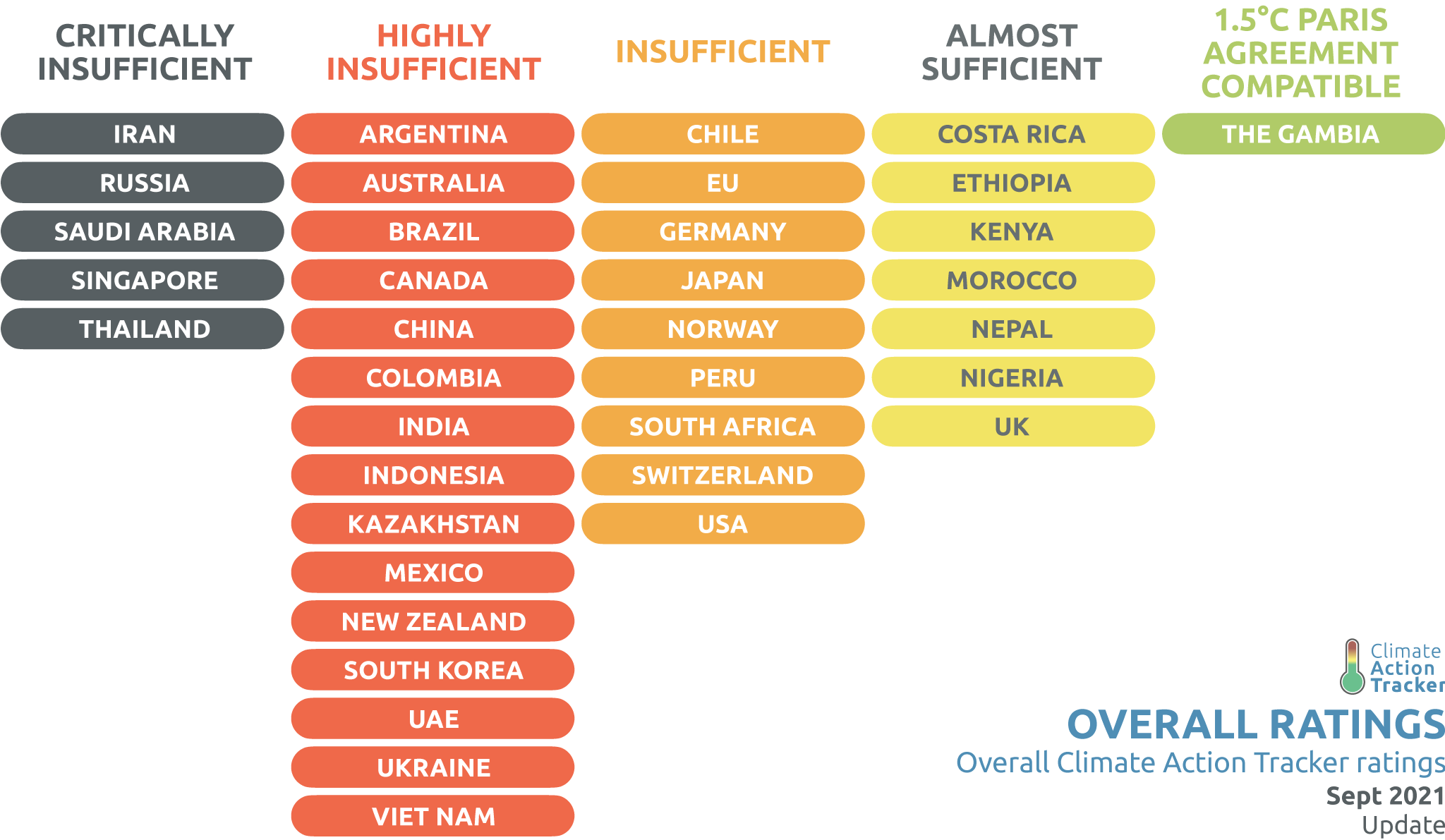Products You May Like
Over 35 countries, including the world’s largest carbon emitters, are falling short of their commitments to curb climate change, according to a bleak new analysis – with the exception of one lone African nation.
The report found few countries are on track to cut carbon emissions and limit runaway climate change to 1.5 °C Celsius of global warming, despite pledging to do so under the 2015 Paris Climate Accord.
“Even countries with strong targets are mostly not on track to meet them, while more have failed to bring forward stronger commitments for 2030,” reads the report from Climate Action Tracker, a collaboration of two scientific organizations, Climate Analytics and NewClimate Institute.
“We estimate that with current actions global emissions will be at roughly today’s level in 2030, we would be emitting twice as much as required for the 1.5 °C limit.”
Policies to deliver financial support to fund clean energy projects in developing countries are also falling short, the analysis found.
It comes just a month after more than 230 scientists issued their starkest warning yet – a “code red for humanity” – in their sixth Intergovernmental Panel on Climate Change (IPCC) report, and ahead of the next round of UN climate talks to be held in November, which some world leaders have called the “last chance” to galvanize political action.
The damning results also resound in the aftermath of historic heatwaves, fearsome floods, and severe wildfires which have devastated Europe and North America in recent months – and in many places, continue to rage.
“An increasing number of people around the world are suffering from ever more severe and frequent impacts of climate change, yet government action continues to lag behind what is needed,” says climate scientist Bill Hare, CEO of Climate Analytics, who co-authored the Climate Action Tracker report.
The report rated countries on a host of measures, such as domestic climate policies, action, and land use, international financial support and emissions targets, and if those targets represent a ‘fair share’ of emissions reductions or include international aviation and shipping.
Of the 36 countries assessed, and the EU, only one nation was given an overall climate rating compatible with stabilizing global warming around 1.5 °C as per the Paris Agreement.
That country is The Gambia, a small West African country that appears to be taking steps to up its renewable energy use.
 Overall Climate Action Tracker ratings, Sept 2021.
Overall Climate Action Tracker ratings, Sept 2021.
Another seven countries – Costa Rica, Kenya, Morocco, Ethiopia, Nepal, Nigeria, and the UK – are not far behind, scoring “almost sufficient” meaning they could get back on track to 1.5 °C “with moderate improvements.”
Notably, the EU, Germany, and the US, have introduced a raft of new policies to update their climate targets but overall, their climate action remains “insufficient”.
The new analysis found a number of major emitters, including Australia, Brazil, Indonesia, and Russia, are stuck on the same or even less ambitious 2030 targets than what they put forward in 2015, at the Paris Agreement.
“Anyone would think they have all the time in the world, when in fact the opposite is the case,” says climate policy expert Niklas Höhne, of the German-based NewClimate Institute, who, like Hare, has contributed to past IPCC reports.
Many countries remain beholden to fossil fuel companies that continue to lobby governments to weaken legislation and deploy dangerous tactics to delay climate action, despite knowing for decades that burning fossil fuels would heat the planet.
2/ The #emissionsgap is still enormous: with all pledges on the table we would be double the emissions in 2030 than would be allowed for a 1.5°C pathway. This gap has narrowed by max 15% since November 2020. pic.twitter.com/UlHgQLzBtF
— ClimateActionTracker (@climateactiontr) September 15, 2021
But the writing is on the wall, and the climate challenge is not insurmountable – we have everything we need to turn the ship around.
A recent study, published in Nature, found that nearly 90 percent of the world’s coal reserves must stay in the ground if we want a 50/50 shot of staying below 1.5 ˚C. Oil and gas production needs to fall, and carbon capture and storage technologies will also be required to pull carbon out of the atmosphere.
What is encouraging is the recent wave of net-zero emissions targets. Some 130 countries, covering 72 percent of global emissions, have now set themselves the goal of achieving net-zero emissions by 2050, which – if implemented – puts the Paris Agreement’s 2 °C temperature target within reach, according to a Nature analysis.
But climate targets are not ‘set and forget’. To keep our one and only planet within a tolerable 1.5 °C of global warming and avoid the calamitous consequences of an even warmer world, we need to cut global carbon emissions in half by 2030 compared to 2010 levels, then neutralize them by 2050.
However, countries such as China, India, and Australia continue to give a lifeline to the coal and natural gas industries, which is a risky strategy given the world’s current trajectory.
“Almost all developed countries need to further strengthen their targets to reduce emissions as fast as possible, to implement national policies to meet them, and to support more developing countries to make the transition,” Höhne, Hare, and colleagues conclude in their report, which can be accessed here.
